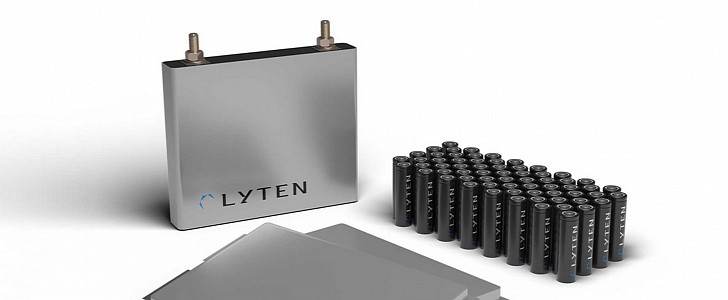When it comes to battery chemistries, one of the most promising is lithium-sulfur. Sulfur is an abundant and cheap material, and a lithium-sulfur battery could theoretically reach 2,600 Wh/kg. That’s ten times the energy density of current ternary cells (NMC or NCA), which implies two things: you can either have the same battery pack capacity with one-tenth of the current size or a battery pack with the same size delivering ten times more energy. So far, all we have are studies to make it feasible, but Lyten said it could finally produce them.
The LytCell EV lithium-sulfur battery platform would not deliver 2,600 Wh/kg. Instead, cells made with the technology would offer three times more energy density than current ternary batteries. Since the best ones provide around 260 Wh/kg, that would imply 780 Wh/kg. However, it seems Lyten was being modest: the company said that batteries with its technology could potentially achieve 900 Wh/kg. If the Lucid Air used these cells, it would either be much lighter or could travel at least 1,560 miles (2,511 kilometers) with a full charge.
Lyten claims to have achieved the Holy Grail of batteries thanks to a 3D graphene-based lithium-sulfur architecture that makes something the company named Sulfur Caging (it even trademarked this name) possible. According to the company, that would arrest “poly-sulfide shuttle.” This phenomenon with Li-S batteries makes them stand just a few cycles before failing. According to Lyten, a LytCell prototype resisted more than 1,400 cycles under DoD (U.S. Department of Defense) test protocols.
The company highlighted all the advantages its Li-S cell can have over current ternary batteries. Without metal oxides, they would not contain the oxygen that makes EV fires so nasty to fight when thermal runaways happen. With much more affordable raw materials, such a battery would immediately make EVs cheaper to build than combustion-engined vehicles if it was available – and here’s the catch.
Lyten believes it will be able to deliver its Li-S platform to 2025 or 2026 model-year vehicles. That means they will arrive somewhere between 2024 and 2026, with 2025 being theoretically a safe bet. Although it can be produced as prismatic, cylindrical, or pouch cells, it seems to be closer to studies than to a production battery. The waiting period suggests the company still has to solve issues with it.
In other words, anyone thrilled with the announcement should be cautious. Lyten still has to prove its claims and find automotive partners that back them up, as QuantumScape did with Volkswagen. For the time being, it is just a promise. As much as the EV world would love to see it come true, it is scalded enough to believe them without solid evidence.
Lyten claims to have achieved the Holy Grail of batteries thanks to a 3D graphene-based lithium-sulfur architecture that makes something the company named Sulfur Caging (it even trademarked this name) possible. According to the company, that would arrest “poly-sulfide shuttle.” This phenomenon with Li-S batteries makes them stand just a few cycles before failing. According to Lyten, a LytCell prototype resisted more than 1,400 cycles under DoD (U.S. Department of Defense) test protocols.
The company highlighted all the advantages its Li-S cell can have over current ternary batteries. Without metal oxides, they would not contain the oxygen that makes EV fires so nasty to fight when thermal runaways happen. With much more affordable raw materials, such a battery would immediately make EVs cheaper to build than combustion-engined vehicles if it was available – and here’s the catch.
Lyten believes it will be able to deliver its Li-S platform to 2025 or 2026 model-year vehicles. That means they will arrive somewhere between 2024 and 2026, with 2025 being theoretically a safe bet. Although it can be produced as prismatic, cylindrical, or pouch cells, it seems to be closer to studies than to a production battery. The waiting period suggests the company still has to solve issues with it.
In other words, anyone thrilled with the announcement should be cautious. Lyten still has to prove its claims and find automotive partners that back them up, as QuantumScape did with Volkswagen. For the time being, it is just a promise. As much as the EV world would love to see it come true, it is scalded enough to believe them without solid evidence.







